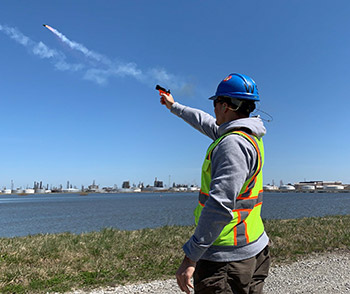Community Protection
The goal of monitoring at the Indiana Harbor and Canal and the Confined Disposal Facility (CDF) is to implement the dredging project safely, efficiently, and in compliance with USACE specifications, while preserving quality of life for the surrounding community.
Air quality is monitored continuously, year-round at and near the Confined Disposal Facility. Water quality and dock air emissions near the CDF are regularly monitored during dredging and sediment disposal activities.
Air Quality
The real-time air monitoring program provides immediate environmental data from a network of air emission monitoring systems located at the CDF. The data is used to prevent negative environmental impacts to the surrounding community and demonstrates that the air quality is consistent with USEPA guidance for remediation projects and within Indiana Department of Environmental Management (IDEM) regulations for air quality.
See the Air Monitoring page to learn more about air monitoring, or visit the Data page to view/download the air monitoring data.
East Chicago Central High School
The United States Geological Survey (USGS) is performing air monitoring at the CDF and at East Chicago Central High School. The monitoring continuously measures air quality near the high school to avoid negative environmental impacts to the surrounding community from dredging and sediment disposal activities. This air monitoring provides data to compare air quality at the CDF site and the potentially affected community, as well as establish long-term trends of air quality at the site and surrounding communities.
Water Quality
The real-time in-stream water quality monitoring program provides immediate data that is used to monitor water quality during dredging activities.
The project aims to remove as much contaminated sediment as efficiently as possible, while minimizing environmental impacts such as the re-suspension of contaminated sediments into the waterway. At the beginning of each dredging event, the program will measure real-time turbidity (a measurement of water cloudiness) in the canal. The program also collects water samples that are analyzed for concentration of total suspended solids (TSS).
Action levels for real-time, in-stream water monitoring have been established to protect environmental quality during dredging. Water Quality Monitoring Data
Action Levels
The air quality and water quality programs are consistent with the USEPA National Environmental Policy Act (NEPA) regulations and guidance. Action levels are guidelines that determine corrective actions that will be taken to protect human health during dredging and sediment disposal into the CDF, and during non-dredging periods. If an action level is exceeded during project activities, control measures will be implemented. Control measures can include reducing equipment speeds or placement rates for dredged material, ceasing dredging operations, or applying water to road or erodible surfaces to suppress dust generation.
Wildlife

USDA APHIS Wildlife Services (WS) conducts wildlife monitoring at the CDF. Personnel conduct wildlife patrols as needed based on wildlife activity. Wildlife that is determined to be at risk of exposure to environmental hazards is managed using effective, legal, and environmentally-responsible control techniques. These techniques include frightening devices (e.g., pyrotechnics, propane cannons, mylar tape, lasers, electronic equipment, remote controlled airboat) and wildlife restraint equipment (e.g., traps, nets).
The CDF habitat includes large tracts of wetland and grassland. Surrounding areas include small tree stands, prairie, canals, and wetland. These habitats attract a broad array of wildlife species, some of which present a high risk to being exposed to environmental hazards on site. Habitat on and around the CDF is managed to reduce or eliminate the area's attractiveness to wildlife, within practicality.
Continued monitoring data is documented at the CDF using quantitative and qualitative techniques to determine species composition, daily and seasonal trends, and spatial patterns that would indicate which species, times, and places wildlife pose a significant threat. Wildlife hazard management operations are conducted during routine CDF inspections. Hazardous wildlife species observed during these inspections are dispersed off the site using a variety of non-lethal techniques. Data collected during control operations include date, time, species, number observed, location, habitat, and management technique used.
Worker Protection
The dredging contractor is committed to providing and maintaining a safe and healthy work environment for all employees and subcontractors. Site-specific health and safety programs and procedures have been implemented to safeguard site personnel, the environment, and the surrounding community exposed to project operations and activities. These programs are continuously updated to ensure state, federal, and USACE occupational, safety, health, and environmental regulations are addressed.

